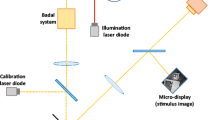Abstract
The function of the accommodation system is to provide a clear retinal image of objects in the visual scene. The system was previously thought to be under simple continuous (i.e., single mode of operation) feedback control, but recent research has shown that it is under discontinuous (i.e., two stimulus-dependent modes of operation) feedback control by means of fast and slow processes. A model using MATLAB/SIMULINK was developed to simulate this dual-mode behavior. It consists of fast and slow components in a feedback loop. The fast component responds to step target disparity with an open-loop movement to nearly reach the desired level, and then the slow component uses closed-loop feedback to reduce the residual error to an acceptable small level. For slow ramps, the slow component provides smooth tracking of the stimulus, whereas for fast ramps, the fast component provides accurate staircase-like step responses. Simulation of this model using a variety of stimuli, including pulse, step, ramp, and sinusoid, showed good agreement with experimental results. Thus, this represents the first dynamic model of accommodation that can accurately simulate the complex dual-mode behavior seen experimentally. The biological significance of this model is that it can be used to quantitatively analyze clinical deficits such as amblyopia and accommodative insufficiency.
Similar content being viewed by others
References
Benjamin, W. J. (1998). Borish’s Clinical Refraction, Philadelphia, PA: W. B. Saunders.
Brodkey, J. D. and L. Stark (1967). Accommodative convergence—an adaptive nonlinear system. IEEE Trans. Syst. Sci. Cybern. 3, 121–133.
Campbell, F. W., J. G. Robson and G. Westheimer (1959). Fluctuations of accommodation under steady viewing conditions. J. Physiol. 145, 579–594.
Campbell, F. W. and G. Westheimer (1960). Dynamics of accommodation responses of the human eye. J. Physiol. 151, 285–295.
Charman, W. N. and G. Heron (1988). Fluctuations in accommodation: a review. Ophthalmic. Physiol. Opt. 8, 153–164.
Ciuffreda, K. J. (1991). Accommodation and its anomalies, in Vision and Visual Dysfunction: Visual Optics and Instrumentation, Vol. 1, W. N. Charman (Ed.), London: Macmillan, pp. 231–279.
Eadie, A. S. and P. J. Carline (1995). Evolution of control system models of ocular accommodation, vergence and their interaction. Med. Biol. Eng. Comput. 33, 517–524.
Fujii, K., K. Kondo and T. Kasai (1970). An analysis of the human eye accommodation system, Osaka University Technical Report No. 925, Vol. 20, pp. 221–236.
Gilmartin, B. and R. E. Hogan (1985). The relationship between tonic accommodation and ciliary muscle innervation. Invest. Ophthalmol. Vis. Sci. 26, 1024–1028.
Griffin, J. R. (1976). Binocular Anomalies—Procedures for Vision Therapy, Chicago, IL: Professional Press.
Hung, G. K. (1997). Quantitative analysis of the accommodative convergence to accommodation ratio: linear and nonlinear models. IEEE Trans. Biomed. Eng. 44, 306–316.
Hung, G. K. (1998a). Dynamic model of the vergence eye movement system: simulation using MATLAB/SIMULINK. Comput. Methods Programs Biomed. 55, 59–68.
Hung, G. K. (1998b). Sensitivity analysis of the stimulus/response function of a static nonlinear accommodation model. IEEE Trans. Biomed. Eng. 45, 335–341.
Hung, G. K. and K. J. Ciuffreda (1988). Dual-mode behaviour in the human accommodation system. Ophthalmic. Physiol. Opt. 8, 327–332.
Hung, G. K. and K. J. Ciuffreda (1994). Sensitivity analysis of relative accommodation and vergence. IEEE Trans. Biomed. Eng. 41, 241–248.
Hung, G. K., K. J. Ciuffreda, J. L. Semmlow and S. C. Hokoda (1983). Model of static accommodative behavior in human amblyopia. IEEE Trans. Biomed. Eng. 30, 665–672.
Hung, G. K., J. L. Semmlow and K. J. Ciuffreda (1982). Accommodative oscillation can enhance average accommodation response: a simulation study. IEEE Trans. Syst. Man Cybern. 12, 594–598.
Hung, G. K., J. L. Semmlow and K. J. Ciuffreda (1986). A dual-mode dynamic model of the vergence eye movement system. IEEE Trans. Biomed. Eng. 33, 1021–1028.
Jiang, B-C. (2000). A modified control model for steady-state accommodation, in Accommodation and Vergence Mechanisms in the Visual System, O. Franzén, H. Richter and L. Stark (Eds), Basel: Birkhäuser Verlag, pp. 235–243.
Kasai, T., M. Unno, K. Fujii, M. Sekiguchi and K. Shinohara (1971). Dynamic characteristics of human eye accommodation system, Osaka University Technical Report, Vol. 21, pp. 569.
Khosroyani, M. (2000). Computer simulation of ocular accommodation and vergence models, MS thesis, Tarbiat Modarres University, Tehran.
Krishnan, V. V. and L. Stark (1975). Integral control in accommodation. Comput. Programs Biomed. 4, 237–255.
Morgan, M. W. (1968). Accommodation and vergence. Am. J. Optom. Arch. Am. Acad. Optom. 45, 417–454.
O’Neill, W. D. (1969). An interactive control system’s analysis of the human lens accommodative controller. Automatica 5, 645–654.
Poggio, G. F. and B. Fischer (1977). Binocular interaction and depth sensitivity in striate and prestriate cortex of behaving rhesus monkey. J. Neurophysiol. 40, 1392–1405.
Semmlow, J. L., G. K. Hung and K. J. Ciuffreda (1986). Quantitative assessment of disparity vergence components. Invest. Ophthalmol. Vis. Sci. 27, 558–564.
Stark, L. (1968). Neurological Control Systems, Studies in Bioengineering, New York: Plenum Press, pp. 369–403.
Stark, L., Y. Takahashi and G. Zames (1965). Nonlinear servo-analysis of human lens accommodation. IEEE Trans. Sys. Sci. Cyber. 1, 75–83.
Sun, F. and L. Stark (1990). Switching control of accommodation: experimental and simulation responses to ramp inputs. IEEE Trans. Biomed. Eng. 37, 73–79.
Toates, F. M. (1972). Accommodation function of the human eye. Psychol. Rev. 52, 828–863.
Tucker, J. and W. N. Charman (1979). Reaction and response times for accommodation. Am. J. Optom. Physiol. Opt. 56, 490–503.
Winn, B., J. R. Pugh, B. Gilmartin and H. Owens (1990). Arterial pulse modulates steady-state ocular accommodation. Curr. Eye Res. 9, 971–974.
Author information
Authors and Affiliations
Corresponding author
Rights and permissions
About this article
Cite this article
Khosroyani, M., Hung, G.K. A dual-mode dynamic model of the human accommodation system. Bull. Math. Biol. 64, 285–299 (2002). https://doi.org/10.1006/bulm.2001.0274
Received:
Accepted:
Issue Date:
DOI: https://doi.org/10.1006/bulm.2001.0274




